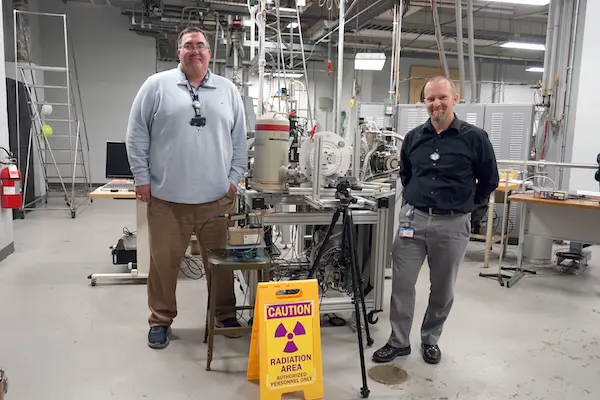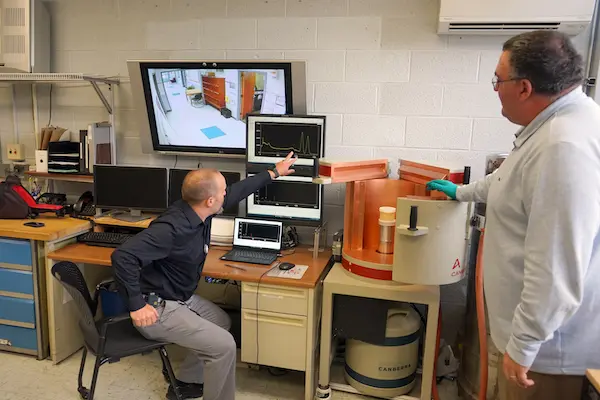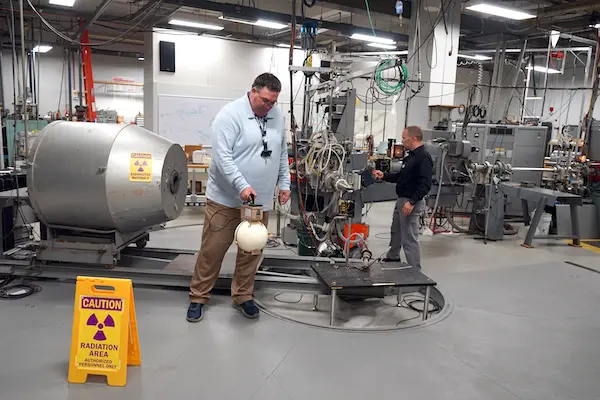Health Physics Society Recognizes UML for Outstanding Training and Prevention Initiatives
 Image by Ed Brennen
Image by Ed Brennen
Director of Radiation Safety Steven Snay, right, and Senior Radiation Safety Specialist Christopher Tavares head up a team that has received the Outstanding Radiation Safety Program award from the Health Physics Society.
07/05/2022
By Ed Brennen
“When your job is to make sure everyone goes home safe, there’s not a lot of excitement,” says Senior Radiation Safety Specialist Christopher Tavares, who has been with the office since 2014. “But nothing happens because of all the work that staff and students put into the program.”
Led by Director of Radiation Safety Steven Snay ’05, ’07, ’18, the office is responsible for the safe receipt, use, storage and disposal of radioactive materials and radiation sources at UMass Lowell — from the 1 megawatt nuclear reactor and 5.5 million volt Van de Graaff particle accelerator at Pinanski Hall on North Campus to the scores of X-ray and MRI machines, lasers, ultraviolet light and magnetic field sources in nearly 100 labs across the university.
Snay and his team, which also includes Radiation Safety Specialist Ceara Buckley ’18, ’20, now have another way of knowing they’re doing a good job: UML has been recognized with the first Outstanding Radiation Safety Program award by the Health Physics Society, an international nonprofit organization of more than 5,000 scientists, physicians, engineers and other radiation safety professionals.
“It’s nice to have the recognition,” says Snay, who has been with the office since his undergraduate days as a physics major (with a radiological health physics option) in 2005. His team will receive the award at the Health Physics Society’s annual meeting this summer in Spokane, Washington.
Part of UML’s Environmental Health and Safety Department, the Radiation Safety Office was originally formed to manage the North Campus research reactor when it came online in the early 1970s. But the office has since grown to become a training ground for students interested in careers in the field of radiation protection. Over the past 15 years, more than 50 undergraduate and graduate students have had internships with the office, with many going on to work at national laboratories, hospitals, universities and nuclear power plants.
The office draws most of its interns from the radiological sciences program in the Kennedy College of Sciences, which is led by Assoc. Prof. Mark Tries. But there are also students from the nuclear science and engineering program in the Francis College of Engineering, as well as from mechanical engineering, robotics and cybersecurity.
 Image by Ed Brennen
Image by Ed Brennen
Director of Radiation Safety Steven Snay, left, shows how a gamma spectrometer works while Christopher Tavares looks on at Pinanski Hall.
“It’s a great opportunity for students to see how cool these places are,” says Snay, a former adjunct faculty member in the radiological sciences program who has supervised independent research projects for more than two dozen students over the past decade.
Community Resource
Radiation safety training is another big part of the office’s work. Each year, it provides online training for upwards of 500 faculty and staff members. The office also supports training exercises for the FBI, the Massachusetts National Guard and the Environmental Protection Agency, as well as local law enforcement, emergency services and hospitals. In 2018, the office collaborated with Radiation Safety and Control Services, a company in Seabrook, New Hampshire, to create a standardized training program at UML for radiation safety technicians in the nuclear power industry.
The office has also helped save UML more than $2 million over the years, Tries estimates.
When the university replaced old exit signs across campus that contained tritium, a radioactive isotope that allows signs to glow without batteries or electricity, Snay says it was going to cost $750,000 to dispose of them.
“We found the right entity that could treat them — take the tritium out and get rid of the non-radioactive component — that cost us a tenth of what it would have for radioactive waste,” he says.
The approach is good for safety — and finances, Snay says.
“We have the expertise; I’m a certified health physicist and our staff and student workers are some of the most resourceful people that I’ve ever met. So why not do the work that can keep costs down for the university and provide better value for students?” he says.
Proper Perspective
One of the trickiest parts of the office’s work, Snay says, is to help people understand the relatively low risk associated with radiological sciences and health physics. According to the Nuclear Regulatory Commission (NRC), which conducts annual reviews of the office, the average American receives a radiation “dose” of about 620 millirem each year, mostly from radon in the air and cosmic rays.
 Image by Ed Brennen
Image by Ed Brennen
Radiation Safety Office staff members Christopher Tavares, left, and Steven Snay give a tour of the research equipment used in the basement of Pinanski Hall.
“Everyone thinks ‘radiation’ and ‘Am I going to glow?’” Snay says. “But with an X-ray exposure, you get roughly a 10 millirem dose of radiation. A CT scan is about 1,000 millirem. Even a smoke detector will give you 0.001 millirem a year. But what’s the benefit? A CT scan looks inside your body and helps doctors find something wrong. A smoke detector wakes you up in a fire and saves your life. Everything we do, we put in perspective.”
Tavares, who manages non-ionizing sources of radiation such as ultraviolet light, radio frequency and lasers, helped Snay conduct a survey of every radiation source on campus several years ago. They didn’t expect to find anything at the Costello Athletic Center, but sure enough, they discovered an infrared device that provides heat therapy for muscles. In the Art Department, they found a laser cutter used for prototyping. And in various labs, they found UV curing machines.
“Our main role is to ensure that any researcher on campus has access to the material they need,” says Snay, who notes that the office has never had a violation or penalty from the NRC or state auditors. “We just want to make sure they do their research safely.”
